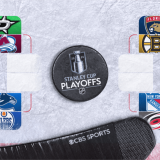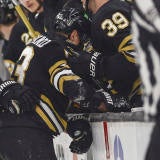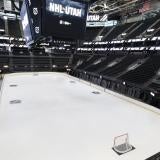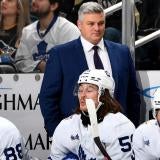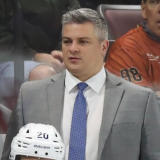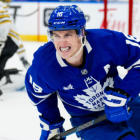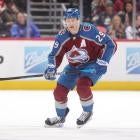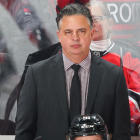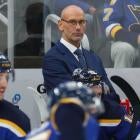
More NHL: Scores | Standings | League Leaders | Odds | Injuries | Power Rankings
Shortly after the final buzzer sounds on the Winter Classic in Ann Arbor, Mich., Wednesday, USA Hockey will announce the 25 players that have been named to its final roster for the U.S. Olympic Men’s Hockey Team.
As the season has progressed, it seems like the picture in some cases got less clear in how this team will be built. The goaltending situation has been drastically changed it seems from the way things seemed before the 2013-14 NHL season started. The defense has a litany of good options, but not a ton of great ones. The only place where projections haven’t drastically been altered is at forward, where the team seems to be as deep as ever.
On top of the already difficult decisions, Team USA’s player pool has been riddled with injuries. A final roster has to be submitted to the IIHF by the first week of January, but can be altered in the event of injury. U.S. general manager David Poile has said he will name players they want on the team regardless of injury status when the team is named and if that player (or those players) are still hurt, they’ll replace later.
Among those strong candidates hurt as the decision looms, goalies Jonathan Quick and Jimmy Howard, forward Ryan Callahan and defensemen Brooks Orpik and Paul Martin. So there’s plenty muddying this decision process.
With that in mind, here’s my final roster projection with a few new picks that may surprise you.
Forwards
| Line | Left Wing | Center | Right Wing |
| Line 1 | Zach Parise | Ryan Kesler | Patrick Kane |
| Line 2 | James van Riemsdyk | Joe Pavelski | Phil Kessel |
| Line 3 | Max Pacioretty | David Backes | Bobby Ryan |
| Line 4 | Dustin Brown | Paul Stastny | Ryan Callahan |
| Extra Forwards | T.J. Oshie | Derek Stepan |
Next in line: Jason Pominville, Alex Galchenyuk, Kyle Okposo, Brandon Saad
At forward, Team USA has its greatest strength. For the first time since the 1998 Olympics, the U.S. has a forward crop that includes some of the best forwards in the NHL today. Patrick Kane is second in the league with 49 points. Bobby Ryan and Phil Kessel are two of the most prolific goal scorers of the last five years in the league. Zach Parise remains one of the game’s more electrifying players as well.
All of those guys were on the 2010 team, but now they’re four years later into their careers and right in their prime years it would seem. That makes for a more formidable forward lineup that the U.S. had in 2010.
This team is going to be built on speed and that have that throughout the lineup. They have players that can play defensively and physically, which is noless important on the big sheet. If anything else, team defense is more important on the big ice. Having a group of forwards to look to in shutdown situations is important. That’s why Ryan Callahan (if healthy), David Backes, Ryan Kesler, Paul Stastny and Dustin Brown should all figure prominently in this lineup.
Callahan’s injury complicates things. He is expected back before the Olympics, but has had a rough season to date. That said, he was one of five players named to Team USA’s leadership core this summer, which means he was expected on the roster. I think they’ll give him every chance to get healthy and make the team before seeking a replacement.
There aren’t a ton of tough decisions in my estimation beyond the choice to make on Islanders forward Kyle Okposo. He is one of the best American scorers this year, but I don’t see him in a top-six or top-nine role over any of the other wingers the U.S. has based on body of work. There’s a chance he could edge out Pacioretty, but a slim one. Not only is Pacioretty scoring at a high clip again this year, he’s got a really strong body of work internationally.
If Callahan needs to be replaced, the door opens more for Okposo, but also puts Jason Pominville and perhaps Brandon Saad more into the mix as replacements later.
Either way, this forward lineup is going to allow the U.S. to play the way they need to on the big ice. The way the forwards are set up also impacts the way the defense will be built. Poile is going to want guys that can get the puck up to these forwards and let them do the work. Mobile, puck-moving Dmen are going to be in high demand.
Defensemen
| Pairing 1 | Ryan Suter | Kevin Shattenkirk |
| Pairing 2 | Ryan McDonagh | Justin Faulk |
| Pairing 3 | Brooks Orpik | Paul Martin |
| Extra Defensemen | Keith Yandle | Cam Fowler |
Next in line: Jack Johnson, Erik Johnson, John Carlson, Dustin Byfuglien, Seth Jones
The defense projections for me and for everyone else have been all over the map. That’s probably because there are so many similarly-skilled defensemen. The U.S. has a vast pool of gifted puck-movers in its selection pool. So many, in fact, that there are many combinations that could make the U.S. competitive at the Olympic level.
One thing I recently learned from Poile was that he was not getting caught up in which way a defenseman shot. He was not going to pick only right-handed guys for the right side of the blue line and lefties for the left side. He thought the big ice made that less of a priority due to the extra time a defender has to get himself into proper position. So that altered how I approached this projection.
The locks to me are still Ryan Suter and Ryan McDonagh. Beyond that, there are so many combinations you could fill in around them. I think Keith Yandle’s ability as a dynamic defenseman makes him too intriguing to leave off at this point. The same goes for Kevin Shattenkirk, who has some excellent two-way capabilities.
Then the decisions get tougher from there. Paul Martin would be a lock if he wasn’t hurt. When I asked David Poile recently about his defense decisions, he mentioned Martin by name as well as Brooks Orpik as guys they’re looking at because they regularly play together and have built-in chemistry. If both are healthy, look for them to make the squad and play together, particularly on the PK.
USA Hockey loves Jack Johnson and he has been fantastic for them internationally on a regular basis. That said, he may have gotten passed up by young Justin Faulk of the Carolina Hurricanes and perhaps John Carlson. Faulk could play a variety of roles for Team USA and may be the better defensively between him and Carlson, which is why I left the latter off the list. I think it's really close between those two, though.
Additionally, Erik Johnson was a tough omission having had Olympic experience already.
I’ve done about four other projections dating back to last year for the Olympic team and have not once included Anaheim Ducks defenseman Cam Fowler. That changed for the last one. After a brilliant rookie year in 2010-11, Fowler was derailed a bit by concussions. This year, he is on pace for a career season offensively and plays a huge role for the NHL’s best team, averaging top-pairing minutes. His speed and puck-moving makes him an ideal option for the U.S. to play the style they want to play and I think he’s earned his spot, even if I may be going out on a limb in projecting him on the roster.
This D corps has to be mobile to make the U.S. a strong transition team. They definitely have the weapons if this is the group.
If Orpik or Martin or both can’t go, I think you’ll see Carlson or either Johnson right back in the mix.
Goalies
1. Ryan Miller
2. Jonathan Quick
3. Jimmy Howard
Next in line: Cory Schneider, Ben Bishop, Tim Thomas
The goaltending situation is still in flux with Jonathan Quick and Jimmy Howard injured. Ryan Miller looks more and more like Team USA’s starter heading into the tournament and I think the U.S. staff would be fine with that. He has experience on the bigger ice surface and he’s playing extremely well in a bad situation. Miller is a supreme competitor and it’s shown all year.
Quick will be named to the roster unless the injury prognosis is bad. He had the back-to-back playoff performances, which won’t be taken lightly in the boardroom when the decision is finally made. He’s had a rough year and his replacements have put up better numbers than him in LA, but based on his entire body of work, Quick is in.
The toughest selection is for the third goalie. For a lot of teams, this is going to be a decision that really doesn’t matter. The No. 3 is unlikely to play much, if at all, in the Olympics. That might not be true for the U.S., given the injury situations currently.
Ben Bishop is the best American goalie in the NHL this year, but I think body of work is important and outside of this year, Bishop’s isn’t the best. That makes him less of a sound option.
Howard is hurt and having a rough year. Schneider has had very little help in New Jersey when he’s between the pipes and Tim Thomas has been less than consistent this year.
I picked Howard, as I have all along, due to body of work. He has a history with USA Hockey and has played well for them internationally. If his injury isn’t cleared up enough, then I think Schneider would be next in line with Bishop and Thomas in the mix in a drastic circumstance.
The goaltending situation isn’t ideal, but Miller is a solid option which should bring some comfort to the U.S. staff.
That'll do it for projections. Now it's time for the actual decision makers to reveal their choices. No matter who they pick, the expectations should still be to compete for a gold medal, especially with a much better pool to select from compared to 2010.
The roster will be announced immediately upon the conclusion of the Winter Classic between the Red Wings and Maple Leafs.







